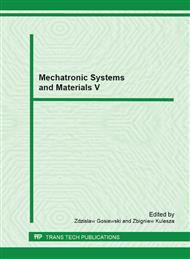p.303
p.309
p.315
p.321
p.326
p.332
p.338
p.344
p.350
Laboratory Station for Research on Angular Translocation in Human Lower Limbs
Abstract:
In the article a construction of a laboratory station for determination of angles in three kinematic pairs of human lower limbs exoskeleton is described. The constructed exoskeleton is supposed to support human lower limbs only on plane vertical to ground. In article the results of measurement of movement parameters of walking human lower limbs obtained using the measuring station. Measurement of angular displacement on the station is realized using six angular displacement absolute transducers. The station is also one of the components contained in lower limb exoskeleton being constructed. The measuring construction will be used to identify actuating systems during exoskeleton construction phase.
Info:
Periodical:
Pages:
326-331
Citation:
Online since:
March 2013
Authors:
Keywords:
Price:
Сopyright:
© 2013 Trans Tech Publications Ltd. All Rights Reserved
Share:
Citation:


